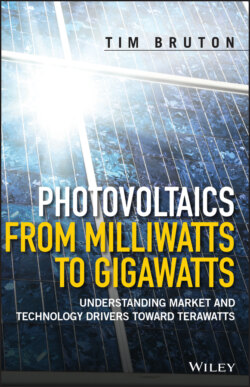Photovoltaics from Milliwatts to Gigawatts

Реклама. ООО «ЛитРес», ИНН: 7719571260.
Оглавление
Tim Bruton. Photovoltaics from Milliwatts to Gigawatts
Table of Contents
List of Tables
List of Illustrations
Guide
Pages
Photovoltaics from Milliwatts to Gigawatts. Understanding Market and Technology Drivers toward Terawatts
Preface
1 The Photovoltaics: The Birth of a Technology and Its First Application. 1.1 Introduction
1.2 Sunlight and Electricity. 1.2.1 The Early Years
1.2.2 The Breakthrough to Commercial Photovoltaic Cells
1.2.3 Hiatus
1.2.4 The First Successful Market: Satellites
1.3 Photovoltaics Demonstrates Success
1.3.1 First Commercial Operation
1.3.2 Continuing Research for Space
1.3.3 Solar Cell Manufacturing
1.4 Gallium Arsenide and III–V Alloys for Space
1.4.1 Single‐Junction GaAs Solar Cells
1.4.2 Multijunction Solar Cells for Space
1.5 Summary
References
2 The Beginnings of a Terrestrial Photovoltaics Industry. 2.1 Introduction
2.2 The 1973 Oil Crisis
2.3 The Way Ahead for Terrestrial Photovoltaics Technology
2.3.1 Basic Silicon Photovoltaic Manufacturing Process
2.3.2 The Flat Plate Solar Array Project
2.3.2.1 Solar‐Grade Silicon
2.3.2.2 Silicon‐Sheet Wafers and Ribbons
2.3.2.3 High‐Efficiency Solar Cells
2.3.2.4 Process Development
2.3.2.5 Engineering Sciences and Reliability
2.3.2.6 Module Encapsulation
2.3.2.7 Cost Goals
2.4 Rise of the US Photovoltaic Manufacturing Industry
2.5 Developments in Europe
2.6 The Transition in Cell Technology from Space to Terrestrial Applications
2.7 Alternatives to Silicon for Solar Cells
2.8 Summary
References
3 The Early Photovoltaic Global Market and Manufacturers. 3.1 Introduction
3.2 Off‐Grid Professional Market. 3.2.1 Navigation Aids
3.2.2 Microwave Repeater Stations
3.2.3 Cathodic Protection
3.2.4 Other Applications
3.2.5 Early Grid‐Connected Application
3.3 Off‐Grid Domestic Market
3.3.1 Solar Home Systems
3.3.2 Water Pumping
3.3.3 Consumer Electronics
3.4 Summary
References
4 Silicon Technology Development to 2010. 4.1 Introduction
4.2 Technologies Supplying the Global Market
4.3 Advantages of Silicon as a Solar Cell Material
4.3.1 Readily Available
4.3.2 Elemental Semiconductor
4.3.3 Nontoxic
4.3.4 Self‐Passivating Oxide
4.3.5 Synergy with the Global Semiconductor Industry
4.4 Silicon Solar Cell Design Features
4.5 Silicon Solar Cell Manufacturing from 1980 to 1990
4.5.1 Silicon Feedstock
4.5.2 Crystallisation
4.5.3 Wafering
4.5.4 Antireflection Coating
4.6 Solar Cell Development to 2000
4.6.1 CZ Cell Development
4.6.2 Multicrystalline Silicon Processing
4.6.3 Integration of Mono‐ and Multicrystalline Silicon Processes
4.6.4 Other Process Technology Changes
4.7 Module Technology
4.8 Summary
References
5 Evolution of Photovoltaic Systems. 5.1 Introduction
5.2 The Off‐Grid Market
5.3 The Decentralised Grid‐Connected Market
5.3.1 The Research Phase: 1974–1989
5.3.2 The Demonstration Phase: 1989–2000
5.3.3 The Commercial Phase: 2000–2019
5.3.3.1 Achievement of Grid Parity
5.3.3.2 Resolution of the Silicon Feedstock Supply
5.4 Utility‐Scale Grid‐Connected Photovoltaic Systems
5.5 Novel Applications
5.6 Summary
References
6 History of Incentives for Photovoltaics. 6.1 The Chicken and Egg Problem
6.2 Capital Subsidies on System Purchase
6.3 Feed‐in‐Tariffs
6.4 Power Purchase Agreements and Other Incentives for Large‐Scale Systems
6.5 Summary
References
7 Difficulties of Alternative Technologies to Silicon. 7.1 Introduction
7.2 Sheet Silicon Processes
7.2.1 Direct Crystallisation of Silicon Sheet
7.2.1.1 Westinghouse Dendritic Web
7.2.1.2 Edge Defined Foil Growth
7.2.1.3 String Ribbon Technology
7.2.2 Cast Silicon Sheet
7.2.2.1 Hoxan Casting Process
7.2.2.2 Ribbon Growth on Substrate
7.2.2.3 Direct Wafer
7.2.2.4 Lift‐Off Wafer Technology
7.3 Thin‐Film Solar Cell Technologies
7.3.1 Copper Sulphide
7.3.2 Amorphous Silicon
7.3.2.1 Amorphous Silicon Manufacturing
7.3.2.2 Manufacture of the Amorphous Silicon Microcrystalline Silicon Tandem Cell
7.3.3 Thin‐Film Crystalline Silicon
7.3.4 Copper Indium Gallium Diselenide (CIGS)
7.3.4.1 CIGS Manufacturing
7.3.5 Cadmium Telluride
7.3.5.1 Cadmium Telluride Manufacturing
7.3.6 Dye‐Sensitised Solar Cells
7.3.7 Polymer (Organic) Solar Cells
7.3.8 Perovskite Solar Cells
7.4 Concentrator Technologies
7.5 Summary
References
8 Current Status of Crystalline Silicon Manufacturing and Future Trends. 8.1 Introduction
8.2 Approaches to High‐Efficiency Silicon Solar Cells on p Type Silicon Wafers
8.2.1 LGBC Solar Cells
8.2.2 Selective Emitters
8.2.3 PERL and PERC Solar Cells
8.2.4 Industrial Manufacture of PERC Cells
8.2.5 Bifacial Module Technology
8.2.6 Light‐Induced Degradation
8.3 Solar Cells with n Type Silicon
8.3.1 SHJ Solar Cells
8.3.2 IBC‐SHJ Solar Cells
8.3.3 n Type IBC Cells Without Amorphous Silicon Passivation
8.4 The Future of Photovoltaic Technology: Toward Terrawatts
8.4.1 III–V Tandems on Silicon
8.4.2 Silicon Tandems Using Perovskites
8.5 Silicon Module Reliability
8.6 Summary
References
9 Lessons Learnt. 9.1 Introduction
9.2 Role of Governments
9.3 Role of the Research Community
9.4 Role of the Manufacturing Industry in Europe and the United States
9.5 Role of China as a Photovoltaics Manufacturing Base
9.6 Potential for Continued Market Growth
9.7 Future Technology Development
9.8 Final Analysis
References
Index. a
b
c
d
e
f
g
h
i
j
k
l
m
n
o
p
r
s
t
u
v
w
z
WILEY END USER LICENSE AGREEMENT
Отрывок из книги
From the rising of the sun to the place where it sets, the name of the Lord is to be praised.
.....
(Source Bell System Technical Journal)
Figure 1.9 Current–voltage curve for a Telstar cell at 28 °C at 100 mW/cm2[46]
.....